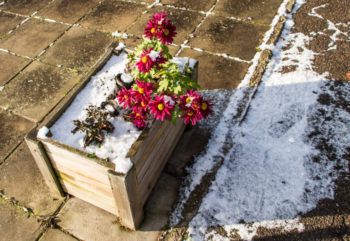How To Prepare Your Plants For Cold Weather
Before cold weather freezes your plants, learn how to prepare your plants for winter and temperatures that drop below freezing. Texas A&M AgriLife Extension Service program specialist for horticulture, Lisa Whittlesey, explains how you can prep your plants for the coming freezing temperatures.
When in doubt, move your potted plants. If you can’t move your plants, cover them.
Cold weather prep for plants in winter
“First of all, make sure that your plants are well watered,” she said. “This can be great protection from light frost damage.”
Drought-stressed plants are more susceptible to cold damage, so watering plants a few days in advance of a cold snap is beneficial. Watering just before the freeze can help too by creating warmth, and the water loses its heat slowly over the hours into the colder temperatures. Used with covers, this watering technique can help make a difference.
“Secondly, remember some plants are more sensitive to cold temperatures than others.” For example, tropical plants will be much more sensitive to cool temperatures and often can be damaged even if the temperature does not hit freezing.
For light frost that doesn’t last for too long, if possible, move potted plants close to the house and preferably on a southern exposure. Placing strands of holiday lights around the plants and covering with a tarp can also help to raise the temperature for protection, particularly if only a light freeze is expected.
How to cover your plant: keeping them warm in winter
Placing cardboard boxes, large trash cans, or even plastic tubs over outdoor plants will provide some protection for sensitive plants, she explained. When covering plants, it’s key to cover them from the ground up. The warmth of the soil is what actually helps keep the plant warm. Since the soil takes much longer to freeze, it offers warmer air than the freezing temperatures surrounding the plant.
To cover plants effectively, drape things over the top of the plant all the way to the soil, then secure the drape with boards or rocks. This will essentially trap warmer air in with the plant.
“If a heavier freeze is expected and watering, lights and covering isn’t enough, moving plants to a southern/western exposure and applying a very heavy layer of mulch or straw in the container can be helpful,” she said. “Anything that can help blanket or cover the plant is beneficial.”
For a long duration of freezing temperatures or if a hard freeze is expected, then it will be best to move plants to the garage or inside.
In flower beds, covering sensitive plants with a heavy covering of leaves can also help provide some frost protection.
Caring for plants indoors during winter
Plants that have been outside often will not receive the light they prefer when moved indoors.
“Try to provide light by placing plants by a window,” Whittlesey said. “Keep well watered and just try to maintain the plant during the colder winter months.”
Plants will not need as much water or fertilizer when indoors. When watering indoor plants, take plants to sink and thoroughly water, allowing water to drain out the bottom of the container. This will prevent as much build-up of salts within the pot.
Rainwater is ideal if you are able to collect it for watering. Using a water-soluble fertilizer about once every four to six weeks will be adequate to provide nutrition for the plant.
Know your plants – are they poisonous?
If you’re moving plants inside, it is always good to know what types of plants you are bringing into your home. “Some popular house plants can be toxic to children and pets,” she said. “Placing plants up higher on a cabinet or a shelf can make them less accessible.”
Knowing something about the plants you have and whether or not they could be toxic to children or pets can be helpful, particularly as you bring them into close quarters with your family and furry friends. Aggie Horticulture has put together some poisonous plant resources.
For more information about frosts and freezes, visit Aggie Horticulture.
This article by Laura Muntean originally appeared in AgriLife Today.






